| Srl | Item |
| 1 |
ID:
084940
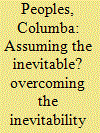

|
|
|
|
|
| Publication |
2008.
|
| Summary/Abstract |
Is armed conflict in and from space inevitable? In recent years a consensus has emerged that space has become increasingly militarized - in the sense that technologies placed in outer space are increasingly used to facilitate and augment traditional military activities. But actual use of weapons in or from outer space remains highly controversial. The aim of this article is to assess the attitudes of major space-faring powers towards space weaponization. Central here, the article argues, is the question of whether the weaponization of space and/or conflict in space (taken here to mean the occurrence of military conflict in outer space itself, or from the Earth directed at any systems deployed in outer space) is inevitable, and the extent to which the major space powers espouse this proposition. This article shows that the idea of inevitability retains a prominent place (although for subtly differing reasons) in American, Chinese, and Russian perspectives on space weaponization. What it is that is inevitable frequently varies, based on assumed but underspecified technological developments. This risks creating a discursively constructed security dilemma that increases the likelihood of actual space weaponization. It leads to the conclusion that renewed negotiations between the major space powers and international cooperative agreements are essential to combat the fatalism of the inevitability thesis.
|
|
|
|
|
|
|
|
|
|
|
|
|
|
|
|
| 2 |
ID:
087168


|
|
|
|
|
| Publication |
2009.
|
| Summary/Abstract |
Shadowing the emergence of new technologies intended for peaceful purposes are unprecedented threats to international security. For example, among the lofe sciences technologies and research areas with the potential for dual use (that is, for weaponization) are synthetic biology and nanotoxicology.
|
|
|
|
|
|
|
|
|
|
|
|
|
|
|
|
| 3 |
ID:
140546
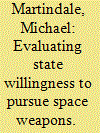

|
|
|
|
|
| Summary/Abstract |
Many studies exist which evaluate the domain of space from a political perspective in order to advocate for a certain position regarding what states ought to do or not do in space. Few studies exist which address how states actually behave with regard to outer space. In an attempt to fill this gap in the literature, the present study evaluates the determinants of state space behavior. The results identify a blend of the realist pursuit of power and liberal normative restrains acting on state space behavior.
|
|
|
|
|
|
|
|
|
|
|
|
|
|
|
|
| 4 |
ID:
110119
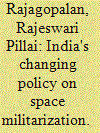

|
|
|
| 5 |
ID:
114244
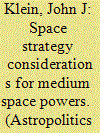

|
|
|
|
|
| Publication |
2012.
|
| Summary/Abstract |
When compared to the strategies of superpowers, the strategies of medium powers are often different due to a medium power's frequent desire to act independently while being comparatively more constrained by available material and fiscal resources. For this reason, the space strategy of medium space powers is different from either emerging or super space powers. The fundamental purpose of any medium space power's space strategy should be to ensure access to and use of celestial lines of communication to support national objectives, whether during peace or conflict. When deciding how best to protect its interests in space, a medium space power will have a variety of non-military and military options. These options may include diplomacy, economic measures, benign defensive technologies, or the employment of offensive actions in space. Though the debate surrounding the weaponization of space continues, it is worth noting that the application of the inherent right of self-defense provides the authority for states to protect their assets or interests when attacked, and this protection may include the use of force in space, if needed.
|
|
|
|
|
|
|
|
|
|
|
|
|
|
|
|
| 6 |
ID:
123391
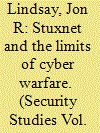

|
|
|
|
|
| Publication |
2013.
|
| Summary/Abstract |
Stuxnet, the computer worm which disrupted Iranian nuclear enrichment in 2010, is the first instance of a computer network attack known to cause physical damage across international boundaries. Some have described Stuxnet as the harbinger of a new form of warfare that threatens even the strongest military powers. The influential but largely untested Cyber Revolution thesis holds that the internet gives militarily weaker actors asymmetric advantages, that offense is becoming easier while defense is growing harder, and that the attacker's anonymity undermines deterrence. However, the empirical facts of Stuxnet support an opposite interpretation; cyber capabilities can marginally enhance the power of stronger over weaker actors, the complexity of weaponization makes cyber offense less easy and defense more feasible than generally appreciated, and cyber options are most attractive when deterrence is intact. Stuxnet suggests that considerable social and technical uncertainties associated with cyber operations may significantly blunt their revolutionary potential.
|
|
|
|
|
|
|
|
|
|
|
|
|
|
|
|
| 7 |
ID:
124926
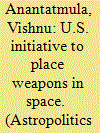

|
|
|
|
|
| Publication |
2013.
|
| Summary/Abstract |
The United States must ensure sustainability and stability in space by protecting its satellites to safeguard national security and economic vitality. Concerns for obtaining this security are mounting, as U.S. satellites are increasingly vulnerable to developing threats from adversaries. This article proposes that the United States will eventually initiate the weaponization of space to defend its space systems and supporting infrastructure. The consequence for such an initiative will manifest a pronounced counteraction from China and Russia, the key spacefaring adversaries of the United States. Such a counteraction will consist of a space-based arms race, as each nation will jockey to position itself as the dominant power in space.
|
|
|
|
|
|
|
|
|
|
|
|
|
|
|
|
| 8 |
ID:
150087
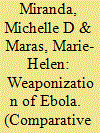

|
|
|
|
|
| Summary/Abstract |
In 2014, the world saw an unprecedented outbreak of Ebola that spanned several countries, including the United States. Considered a highly contagious, extremely virulent bioterrorism agent, the introduction of Ebola within U.S. borders uncovered myriad deficiencies in emergency response and preparedness, international travel policies and restrictions, and how the U.S. healthcare system handles such viral agents in infected individuals. This article explores the potential for the weaponization of Ebola, looking in particular at its plausibility for use in a bioterrorism attack. After describing the epidemiology of Ebola and its classification as a bioterrorism agent, this article examines the risk of the weaponization of Ebola and delineates the weaknesses identified in the ability of the United States to handle Ebola cases during the 2014 outbreak, which could be exploited by terrorists to effectively execute a bioterrorism attack.
|
|
|
|
|
|
|
|
|
|
|
|
|
|
|
|
| 9 |
ID:
057952
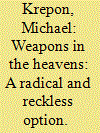

|
|
|